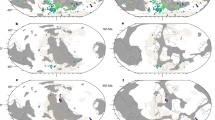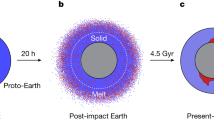Abstract
Mercury is the smallest and least tectonically active of the terrestrial planets1,2. Although Mercury’s ancient, cratered surface resembles the Moon, it has the largest ratio of metallic core to silicate mantle among the terrestrial planets3 as well as an internal magnetic field4. Images from the Mariner 10 spacecraft reveal lobate scarps, so called because of their curved or scalloped edges, which have been interpreted to be high-angle thrust faults5,6,7,8 resulting from a period of global contraction. A range of mechanisms has been invoked to explain the stresses leading to global contraction, including cooling and core formation5,9, tidal effects due to gravitational interactions with the Sun10, mantle convection11 and the impact that formed the Caloris basin12. Here I present numerical simulations of the three-dimensional nature of convection within Mercury’s silicate mantle. The model yields a regularly spaced pattern of convection, in which upwelling regions of the mantle assume linear, sheet-like shapes at low latitudes and a nearly hexagonal pattern near the poles. The distribution of resultant surface stresses is consistent with the observed pattern of lobate scarps, suggesting that the compressive features record an ancient pattern of mantle convection11, in addition to global contraction. The gravity and topographic data returned from the MESSENGER 11 mission13 will help test this hypothesis.
This is a preview of subscription content, access via your institution
Access options
Subscribe to this journal
Receive 12 print issues and online access
$259.00 per year
only $21.58 per issue
Buy this article
- Purchase on Springer Link
- Instant access to full article PDF
Prices may be subject to local taxes which are calculated during checkout



Similar content being viewed by others
References
Solomon, S. C. Mercury: The enigmatic innermost planet. Earth Planet. Sci. Lett. 216, 441–455 (2003).
Strom, R. G. & Sprague, A. L. Mercury: The Iron Planet 219 (Springer, New York, 2003).
Harder, H. & Schubert, G. Sulfur in Mercury’s core? Icarus 151, 118–122 (2001).
Ness, N. F., Behannon, K. W., Lepping, R. P. & Whang, Y. C. Observations of Mercury’s magnetic field. Icarus 28, 479–488 (1976).
Strom, R. G., Trask, N. J. & Guest, J. E. Tectonism and volcanism on Mercury. J. Geophys. Res. 80, 2478–2507 (1975).
Solomon, S. C. The relationship between crustal tectonics and internal evolution in the Moon and Mercury. Phys. Earth Planet. Inter. 15, 135–145 (1977).
Watters, T. R., Robinson, M. S. & Cook, A. C. Topography of lobate scarps on Mercury: New constraints on the planet’s contraction. Geology 26, 991–994 (1998).
Watters, T. R., Schultz, R. A. & Robinson, M. S. Displacement–length relations of thrust faults associated with lobate scarps on Mercury and Mars: Comparison with terrestrial faults. Geophys. Res. Lett. 27, 3659–3662 (2000).
Melosh, H. J. & McKinnon, W. B. in Mercury (eds Vilas, F., Chapman, C. R. & Matthews, M. S.) 374–400 (Univ. of Arizona Press, Tucson, 1988).
Melosh, H. J. & Dzurisin, D. Mercurian global tectonics: A consequence of tidal despinning? Icarus 35, 227–236 (1978).
Watters, T. R., Robinson, M. S., Bina, C. R. & Spudis, P. D. Thrust faults and the global contraction of Mercury. Geophys. Res. Lett. 31, L04701 (2004).
Thomas, P. G., Masson, P. & Fleitout, L. in Mercury (eds Vilas, F., Chapman, C. R. & Matthews, M. S.) 401–428 (Univ. of Arizona Press, Tucson, 1988).
Solomon, S. C. et al. The MESSENGER mission to Mercury: Scientific objectives and implementation. Planet. Space Sci. 49, 1445–1465 (2001).
Zhong, S., Zuber, M. T., Moresi, L. N. & Gurnis, M. The role of temperature-dependent viscosity and surface plates in spherical shell models of mantle convection. J. Geophys. Res. 105, 11063–11082 (2000).
Tan, E., Choi, E., Thoutireddy, P., Gurnis, M. & Aivazis, M. GeoFramework: Coupling multiple models of mantle convection within a computational framework. Geochem. Geophys. Geosyst. 7, Q06001 (2006).
Steinbach, V. & Yuen, D. A. Effects of depth-dependent properties on the thermal anomalies produced in flush instabilities from phase transitions. Phys. Earth Planet. Int. 86, 165–183 (1994).
Hauck II, S. A., Dombard, A. J., Phillips, R., J. & Solomon, S. C. Internal and tectonic evolution of Mercury. Earth Planet. Sci. Lett. 222, 713–728 (2004).
Schubert, G., Ross, M. N., Stevenson, D. J. & Spohn, T. in Mercury (eds Vilas, F., Chapman, C. R. & Matthews, M. S.) 429–460 (Univ. of Arizona Press, Tucson, 1988).
Redmond, H. L & King, S. D. Does mantle convection currently exist on Mercury? Phys. Earth Planet. Int. 164, 221–231 (2007).
Karato, S.-I. & Wu, P. Rheology of the upper mantle: A synthesis. Science 260, 771–778 (1993).
Schubert, G., Turcotte, D. L. & Olson, P. Mantle Convection in the Earth and Planets 940 (Cambridge Univ. Press, Cambridge, 2001).
Turcotte, D. L. & Schubert, G. Geodynamics: Application of Continuum Physics to Geological Problems (Wiley, New York, 1982).
Stanley, S., Bloxham, J., Hutchinson, W. E. & Zuber, M. T. Thin shell dynamo models consistent with Mercury’s weak observed magnetic field. Earth Planet. Sci. Lett. 234, 27–38 (2005).
Solomatov, V. S. & Moresi, L.-N. Three regimes of mantle convection with non-Newtonian viscosity and stagnant lid convection on terrestrial planets. Geophys. Res. Lett. 24, 1907–1910 (1997).
Richards, M. A., Ricard, Y., Lithgow-Bertelloni, C., Spada, G. & Sabadini, G. An explanation for Earth’s long-term rotational stability. Science 275, 372–375 (1997).
Steinberger, B. & O’Connell, R. J. Changes of the Earth’s rotation axis owing to advection of mantle density heterogeneities. Nature 387, 169–173 (1997).
Watters, T. R., Schultz, R. A., Robinson, M. S. & Cook, A. C. The mechanical and thermal structure of Mercury’s early lithosphere. Geophys. Res. Lett. 29, 1542 (2002).
Nimmo, F. & Watters, T. R. Depth of faulting on Mercury: Implications for heat flux and crustal and effective elastic thickness. Geophys. Res. Lett. 31, L02701 (2004).
Elkins-Tanton, L. T., Zaranek, S. E., Parmentier, E. M. & Hess, P. C. Early magnetic field and magmatic activity on Mars from magma ocean cumulate overturn. Earth Planet. Sci. Lett. 236, 1–12 (2005).
Acknowledgements
I acknowledge support from NSF award EAR-0317638.
Author information
Authors and Affiliations
Corresponding author
Supplementary information
Supplementary Information
Supplementary table S1 (PDF 77 kb)
Rights and permissions
About this article
Cite this article
King, S. Pattern of lobate scarps on Mercury’s surface reproduced by a model of mantle convection. Nature Geosci 1, 229–232 (2008). https://doi.org/10.1038/ngeo152
Received:
Accepted:
Published:
Issue Date:
DOI: https://doi.org/10.1038/ngeo152
This article is cited by
-
Widespread small grabens consistent with recent tectonism on Mercury
Nature Geoscience (2023)
-
Mercury’s global contraction much greater than earlier estimates
Nature Geoscience (2014)



